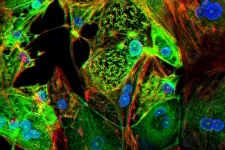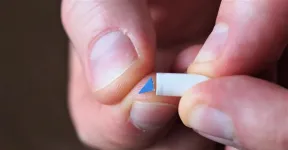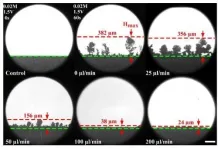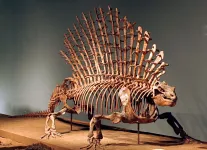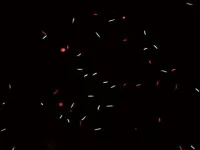(Press-News.org) Since early in the pandemic, COVID-19 has been associated with heart problems, including reduced ability to pump blood and abnormal heart rhythms. But it's been an open question whether these problems are caused by the virus infecting the heart, or an inflammatory response to viral infection elsewhere in the body. Such details have implications for understanding how best to treat coronavirus infections that affect the heart.
A new study from Washington University School of Medicine in St. Louis provides evidence that COVID-19 patients' heart damage is caused by the virus invading and replicating inside heart muscle cells, leading to cell death and interfering with heart muscle contraction. The researchers used stem cells to engineer heart tissue that models the human infection and could help in studying the disease and developing possible therapies.
The study is published Feb. 26 in the Journal of the American College of Cardiology: Basic to Translational Science.
"Early on in the pandemic, we had evidence that this coronavirus can cause heart failure or cardiac injury in generally healthy people, which was alarming to the cardiology community," said senior author Kory J. Lavine, MD, PhD, an associate professor of medicine. "Even some college athletes who had been cleared to go back to competitive athletics after COVID-19 infection later showed scarring in the heart. There has been debate over whether this is due to direct infection of the heart or due to a systemic inflammatory response that occurs because of the lung infection.
"Our study is unique because it definitively shows that, in patients with COVID-19 who developed heart failure, the virus infects the heart, specifically heart muscle cells."
Lavine and his colleagues -- including collaborators Michael S. Diamond, MD, PhD, the Herbert S. Gasser Professor of Medicine, and Michael J. Greenberg, PhD, an assistant professor of biochemistry and molecular biophysics -- also used stem cells to engineer tissue that models how human heart tissue contracts. Studying these heart tissue models, they determined that viral infection not only kills heart muscle cells but destroys the muscle fiber units responsible for heart muscle contraction.
They also showed that this cell death and loss of heart muscle fibers can happen even in the absence of inflammation.
"Inflammation can be a second hit on top of damage caused by the virus, but the inflammation itself is not the initial cause of the heart injury," Lavine said.
Other viral infections have long been associated with heart damage, but Lavine said SARS-CoV-2, the virus that causes COVID-19, is unique in the effect it has on the heart, especially in the immune cells that respond to the infection. In COVID-19, immune cells called macrophages, monocytes and dendritic cells dominate the immune response. For most other viruses that affect the heart, the immune system's T cells and B cells are on the scene.
"COVID-19 is causing a different immune response in the heart compared with other viruses, and we don't know what that means yet," Lavine said. "In general, the immune cells seen responding to other viruses tend to be associated with a relatively short disease that resolves with supportive care. But the immune cells we see in COVID-19 heart patients tend to be associated with a chronic condition that can have long-term consequences. These are associations, so we will need more research to understand what is happening."
Part of the reason these questions of causation in heart damage have been hard to answer is the difficulty in studying heart tissue from COVID-19 patients. The researchers were able to validate their findings by studying tissue from four COVID-19 patients who had heart injury associated with the infection, but more research is needed.
To that end, Lavine and Diamond, are working to develop a mouse model of the heart injury. To emphasize the urgency of the work, Lavine pointed to the insidious nature of the heart damage COVID-19 can cause.
"Even young people who had very mild symptoms can develop heart problems later on that limit their exercise capacity," Lavine said. "We want to understand what's happening so we can prevent it or treat it. In the meantime, we want everyone to take this virus seriously and do their best to take precautions and stop the spread, so we don't have an even larger epidemic of preventable heart disease in the future."
INFORMATION:
This work was supported by funding from the National Institutes of Health (NIH), grant numbers R01HL141086, R01 HL138466, R01 HL139714, 75N93019C00062 and R01 AI127828; the Burroughs Welcome Fund, grant number 1014782; the Defense Advanced Research Project Agency, grant number HR001117S0019; the March of Dimes Foundation, grant number FY18-BOC-430198; The Foundation for Barnes-Jewish Hospital, grant number 8038-88; and the Children's Discovery Institute of Washington University and St. Louis Children's Hospital, grant numbers CH-II-2017-628 and PM-LI-2019-829. Imaging was performed in the Washington University Center for Cellular Imaging (WUCCI), which is funded in part by the Children's Discovery Institute of Washington University and St. Louis Children's Hospital, grant numbers CDI-CORE-2015-505 and CDI-CORE-2019-813; and The Foundation for Barnes-Jewish Hospital, grant number 3770. The authors thank Dr. Cynthia Goldsmith for help interpreting electron microscopy micrographs and the McDonnell Genome Institute (MGI) at Washington University School of Medicine for assistance in performing sequencing and analysis.
Bailey AL, et al. SARS-CoV-2 infects human engineered heart tissues and models COVID-19 myocarditis. Journal of the American College of Cardiology: Basic to Translational Science. Feb. 26, 2021.
Washington University School of Medicine's 1,500 faculty physicians also are the medical staff of Barnes-Jewish and St. Louis Children's hospitals. The School of Medicine is a leader in medical research, teaching and patient care, ranking among the top 10 medical schools in the nation by U.S. News & World Report. Through its affiliations with Barnes-Jewish and St. Louis Children's hospitals, the School of Medicine is linked to BJC HealthCare.
Positive psychological effects associated with taking small doses of psychedelic drugs are likely the result of users' expectations, suggests a study published today in eLife.
The study - the largest placebo-controlled trial on psychedelics to date - used an innovative 'self-blinding citizen science' approach, where members of the public who were already microdosing implemented their own placebo control following online instructions. The results from the trial may influence future studies in real-world settings.
There has been renewed interest in studying whether psychedelic drugs may be a useful treatment for depression, addiction, obsessive-compulsive disorders and other conditions. Few small studies have previously suggested that microdoses ...
A new paper from associate professor Jiandi Wan's group in the UC Davis Department of Chemical Engineering, published in Science Advances, proposes a potential solution to dendrite growth in rechargeable lithium metal batteries. In the paper, Wan's team prove that flowing ions near the cathode can potentially expand the safety and lifespans of these next-generation rechargeable batteries.
Lithium metal batteries use lithium metal as the anode. These batteries have a high charge density and potentially double the energy of conventional lithium ion batteries, but safety is a big concern. When they charge, some ions are reduced to lithium ...
In a new study from Shiley Eye Institute at UC San Diego Health, researchers have identified a potential new marker that shows cardiovascular disease may be present in a patient using an optical coherence tomography (OCT) scan -- a non-invasive diagnostic tool commonly used in ophthalmology and optometry clinics to create images of the retina. The finding suggests it may be possible to detect heart disease during an eye examination.
In the paper published March 2, 2021 in EClinical Medicine by The Lancet, the research team examined lesions of the retina, the inner-most, light-sensitive layer of the eye, to determine if a cardiovascular disorder may be present.
"The eyes are a window into our health, and many diseases can manifest in the eye; cardiovascular ...
NEW YORK, NY--March 2, 2021--In March and April 2020, mental health claim lines for individuals aged 13-18, as a percentage of all medical claim lines, approximately doubled over the same months in the previous year. At the height of the spring wave of the COVID-19 pandemic, this rise in mental health claim lines amounted to 97.0 percent in March and 103.5 percent in April. These are among the many findings in FAIR Health's new white paper, the seventh in its COVID-19 studies, The Impact of COVID-19 on Pediatric Mental Health: A Study of Private Healthcare Claims.
In those same months of March and April 2020, all medical claim lines (including mental health claim lines) decreased by approximately ...
When it comes to the evolution of the mammal spine -- think of animals whose backbone allows them to gallop, hop, swim, run, or walk upright -- a key part of the tale is quite simple.
Because nonmammalian synapsids, the extinct forerunners to mammals, had similar traits to living reptiles (like having their limbs splayed out to the side instead of tucked into their body like today's mammals), the strongheld belief was that they must have also moved in similar ways. Primarily, their backbones must have moved side-to-side, bending like those of modern lizards, instead of the up-and-down bending motion mammal spines are known for. It's believed over time, and in response to selective pressures, the mammal spine evolved from that lizard like side-to-side bending ...
UNIVERSITY PARK, Pa. -- By modeling wolves in Yellowstone National Park, researchers have discovered that how a population is organized into social groups affects the spread of infectious diseases within the population. The findings may be applicable to any social species and could be useful in the protection of endangered species that suffer from disease invasion.
Like other social carnivores, wolves tend to form territorial social groups that are often aggressive toward each other and may lead to fatalities. During these encounters, infectious diseases -- like mange and canine distemper -- can spread between groups, which can further reduce the number of individuals in a group.
"Previous social group-disease models have assumed that groups do not change ...
WESTMINSTER, Colorado - March 02, 2021 - Herbicide-resistant weeds have fueled a growing demand for effective, nonchemical weed controls. Among the techniques used are chaff carts, impact mills and other harvest-time practices that remove or destroy weed seeds instead of leaving them on the field to sprout.
A recent article in the journal Weed Science explores whether such harvest-time controls would be effective against downy brome, Italian ryegrass, feral rye and rattail fescue - weeds that compete with winter wheat in the Pacific Northwest. Researchers set out to determine whether ...
New research has found that shrimp like creatures on the South Coast of England have 70 per cent less sperm than less polluted locations elsewhere in the world. The research also discovered that individuals living in the survey area are six times less numerous per square metre than those living in cleaner waters.
This discovery, published today in Aquatic Toxicology, mirrors similar findings in other creatures, including humans. The scientist leading research at the University of Portsmouth believes pollutants might be to blame, further highlighted by this ...
Resveratrol is a plant compound found primarily in red grapes and Japanese knotweed. Its synthetic variant has been approved as a food ingredient in the EU since 2016. At least in cell-based test systems, the substance has anti-inflammatory properties. A recent collaborative study by the Leibniz Institute for Food Systems Biology at the Technical University of Munich and the Institute of Physiological Chemistry at the University of Vienna has now shown that the bitter receptor TAS2R50 is involved in this effect. The team of scientists led by Veronika Somoza ...
CHICAGO, March 2, 2021 -- More than 70 percent of dentists surveyed by the American Dental Association (ADA) Health Policy Institute are seeing an increase of patients experiencing teeth grinding and clenching, conditions often associated with stress. This is an increase from ADA data released in the fall that showed just under 60 percent of dentists had seen an increase among their patients.
"Our polling has served as a barometer for pandemic stress affecting patients and communities seen through the eyes of dentists," said Marko Vujicic, Ph.D., chief economist and vice president of the ADA Health Policy Institute. "The increase over time suggests stress-related conditions have become substantially more prevalent since the onset of COVID-19."
The ...
